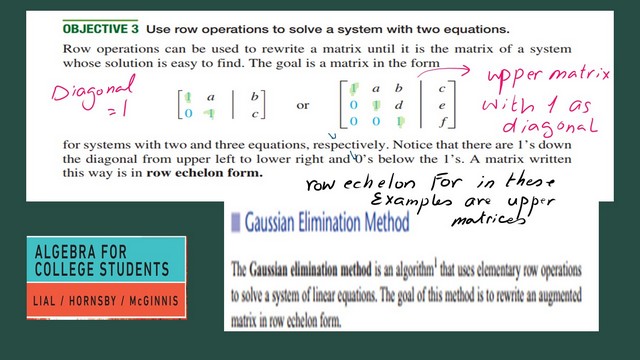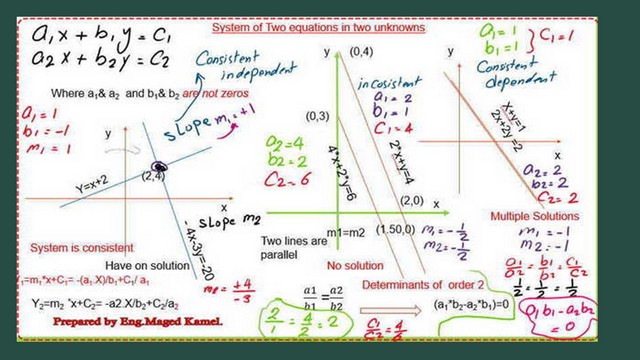Last Updated on March 22, 2025 by Maged kamel
Introduction to types of linear systems-Two variables.
There are three types of linear systems-Two variables; the detailed view can be viewed as per the next slide image:
1-The first type is the consistent independent, which is a system of linear equations that is consistent independent when it has exactly one solution. When this is the case, the graphs of the lines in the system cross at exactly one point.
2-The second type is the consistent dependent. A system of linear equations is consistent -dependent if it has an infinite number of solutions. When this is the case, the graphs of the lines in the system are the same, meaning the equations in the system represent the same line.
3-The third type is inconsistent. A system of linear equations is inconsistent if it has no solutions.
When this is the case, the graphs of the lines in the system do not intersect, meaning they are parallel.

Matrix Row operations.
It is necessary to review the matrix row operations prior to solving types of linear systems with two variables.
1-The first operation is to switch between any two rows. For the example included in the slide image, we have two rows of a (2×3) matrix. The first row is ( 2 5 3), while the second row is ( 3 4 6). It is possible to switch row 1 to row 2, and the reverse can also be done.
2-The second operation is the multiplication of any row by a non-zero constant. For instance, for the same matrix previously indicated, we can multiply the first row by 3, and then a new row is formed by the value of the product of 3 by the first row.
3-The third operation is the addition of two rows and the output is placed as a new second row.

The Use of row operations to solve a system of two/three equations.
By using row operations, we can convert a system of linear equations with two unknowns to a row echelon form, for which the diagonal will contain a series of 1’s, while the second row/the first column is zero.
By using row operations, we can convert a system of linear equations with three unknowns to an echelon form. For this form, the diagonal will contain a series of 1s, while the second row/the first column and the Third row/the first column are zero.
The Gaussian elimination method is an algorithm that uses elementary row operations to solve a system of linear equations.
This method aims to rewrite an augmented matrix in row echelon form. Please refer to College Algebra and Trigonometry chapter -10 from Richard N. Aufmann ‘s book. This is quoted from Algebra for College Students by Margret Lial. This is the Amazon link for the book.

Solved problems for types of linear systems-Two variables.
The linear system variables can be expressed as two equations. The first equation is a1*x+b1*y=c1. The second equation is a2*x+b2*y=c2, where a1, a2,c1, and c2 are non-zeros.
1-The first type is the consistent independent, two lines intersecting with each other, for example, we have the first equation as y=x+2, while the second equation is (-4x-3y =-20).
Solving these two equations together, we get an intersecting point as (2,4). The intersecting point will satisfy the two equations.
For the inconsistent, a system of linear equations is inconsistent if it has no solutions. We have two equations. For example, the first line equation is 2x+y=4, while the second line equation is 2x+2y=6.
The system of equations is parallel to each other, so we can get an equal slope as m1=m2.
The consistent dependent is a system of linear equations is consistent, where we have multiple solutions. We have two equations.(x+y=1) and (2x+2y=2).

For the given equations, we will use the following steps to figure out the types of linear systems variables.
Steps used to find Types of linear systems-Two variables.
Case of consistent independence.
The first equation is -x+y=+2, while the second is (-4x-3y =-20). We will follow the next steps to find Types of linear systems
Step 1:We write the two equations in augmented form.
Step 2: Make sure that we have 1 in the first column/first row; otherwise, we will do the necessary row operation.
Step 3: Use the row operation to make the element of the 2nd/first column equal 0. This is done by multiplying the first row by(-4) and adding it to row 2. The result will be placed in the second row.
We have used the multiplication and addition row operations. The elements of the first row have been multiplied by -1.

The next step is to divide the second row by (-7), to let the diagonal of the 2nd row/the second column.
The augmented matrix will lead us to two new equations. The first equation is -x+y=2, and the second equation is y=4. We will substitute by y=4 in the -x+y=2. We get a value of x=2. Thus, we have an intersecting point (2&4).

Case of a consistent dependent.
The first equation is x+y=1, while the second is (2x+2y=2). We will follow the next steps to find Types of linear systems.
Step 1:We write the two equations in augmented form.
Step 2: Make sure that we have 1 in the first column/first row; otherwise, we will do the necessary row operation.
Step 3: Use the row operation to make the element of the 2nd/first column equal 0. This is done by multiplying the first row by(-2) and adding it to row 2. The result will be placed in the second row.
The augmented matrix will lead us to two new equations. The first equation is -x+y=2, the second equation is 0*x+0*y=0
There are multiple solutions for these two equations. This is a typical case of consistent dependent equations.

The next slide shows the graph of the two lines.

A system of linear equations is inconsistent if it has no solutions.
The first equation is 2x+y=4, while the second is (4x+2y=+6). We will follow the next steps to find Types of linear systems.
Step 1:We write the two equations in augmented form.
Step 2: Use the row operation to make the element of the 2nd/first column equal 0. This is done by multiplying the first row by(-2) and adding it to row 2. The result will be placed in the second row.
The augmented matrix will lead us to two new equations. The first equation is 2x+y=1; the second equation is 0*x+0*y=-2
since for any value of x,y the left-hand side is zero, while the right-hand side is equal to -2, this is nonlogic since zero does not equal -2, and this will lead to a contradiction.
This is a typical case of inconsistent equations.

The next slide shows the graph of the two parallel lines.

This is a link to the following post: Easy introduction to row echelon form.
This is a link to the matrix calculator.
For a useful external link, math is fun for the matrix part.